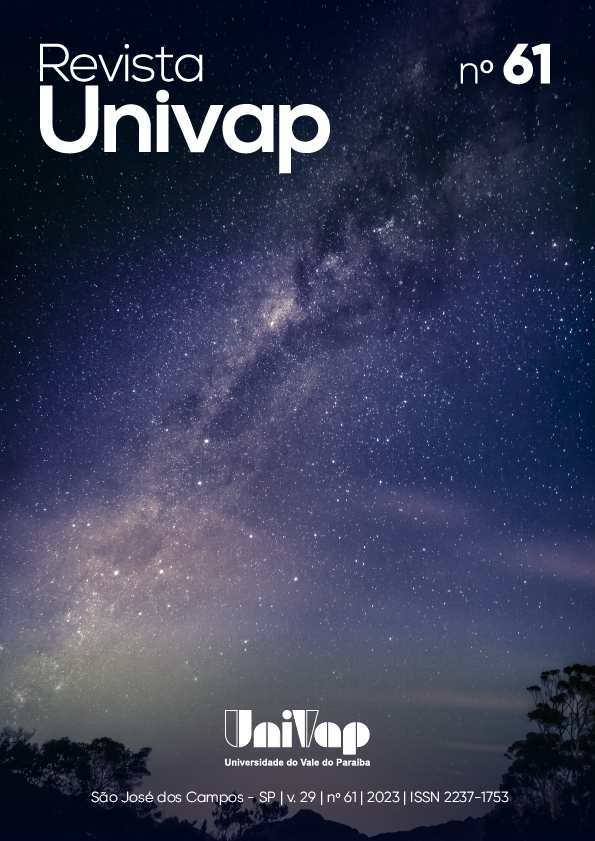UNDERSTANDING THE ASTROPHYSICAL-ICE NANOSTRUCTURES FORMATION THROUGH CLASSICAL MOLECULAR DYNAMICS
DOI:
https://doi.org/10.18066/revistaunivap.v29i61.4415Keywords:
Classical molecular dynamics, astrophysical ice, formation of substrate-adsorbed ice nanostructures, astrochemistry, astrophysicsAbstract
Astrophysical ices (formed by water, among other molecules) act as a catalyst and a reservoir of carbonaceous species, both of which have major implications for astrobiology. In this work, we studied the formation of astrophysical ice nanostructures found in the interstellar medium, having a sheet of graphene as a catalyst substrate, using the classical molecular dynamics technique to model these astrophysical environments. For this, two systems were designed: the first composed of graphene and and the second composed of graphene, and . Initially, a simulation box was built where the area was delimited by graphene whose height varied from 4, 6, 8 and 10 nm. The molecules were evenly distributed throughout the box. The molecular dynamics technique proved to be a promising tool to understand the phenomenon of adsorption of molecules on the substrate, allowing us to realize that the random distribution of molecules in the system interferes with the geometric structure formed by an ice nanostructure. This study allows us to understand, from the nanometric point of view, the influence of some physical-chemical parameters, regarding the formation of nanostructures of astrophysical ices, such as the number of hydrogen bonds, the initial size of the simulation box, and its density during the freezing process
Downloads
References
Abraham, M. J., Van Der Spoel, D., Hess, B. & Lindahl, E. E. (2014). The GROMACS development team, GROMACS User Manual (version 4.6.7).
Anders, C. & Urbassek, H. M. (2013). Impacts into cosmic ice surfaces: A molecular-dynamics study using the Reax force field. Nuclear Instruments and Methods in Physics Research Section B, 303, 200–204. https://doi.org/10.1016/j.nimb.2012.10.015
Andersson, S. & Van Dishoeck, E. F. (2008). Photodesorption of water ice. Astronomy & Astrophysics, 491, 907–916. https://doi.org/10.1051/0004-6361:200810374
Andersson, S., Al-Halabi, A., Kroes, G.-J. & Van Dishoeck, E. F. (2006). Molecular-dynamics study of photodissociation of water in crystalline and amorphous ices. The Journal of Chemical Physics, 124, 064715-1 - 064715-14. https://doi.org/10.1063/1.2162901
Arasa, C., Van Hemert, M. C., Van Dishoeck, E. F. & Kroes, G. J. (2013). Molecular Dynamics Simulations of CO_2 Formation in Interstellar Ices. The Journal of Physical Chemistry A, 117(32), 7064–7074.
Arasa, C., Andersson, S., Cuppen, H. M., van Dishoeck, E. F. & Kroes, G.-J. (2010). Molecular dynamics simulations of the ice temperature dependence of water ice photodesorption. The Journal of Chemical Physics, 132, 184510-1 - 184510-12. https://doi.org/10.1063/1.3422213
Berendsen, H. J. C., Spoel, D. van der. & Drunen, R. van. (1995). GROMACS: A message-passing parallel molecular dynamics implementation. Computer Physics Communications, 91, 43–56.
DePaul, A. J., Thompson, E. J., Patel, S. S., Haldeman, K. & Sorin, E. J. (2010). Equilibrium conformational dynamics in an RNA tetraloop from massively parallel molecular dynamics. Nucleic Acids Research, 38, 4856–4867. http://doi.org/10.1093/Nar/Gkq134
Ehrenfreund, P. & Charnley, S. B. (2000). Organic Molecules in the Interstellar Medium, Comets, and Meteorites: A Voyage from Dark Clouds to the Early Earth. Annu. Rev. Astron. Astrophys, 38, 427–483. https://doi.org/10.1146/annurev.astro.38.1.427
Freivogel, P., Fulara, J. & Maier, J. P. (1994). Highly Unsaturated Hydrocarbons as Potential Carriers of Some Diffuse Interstellar Bands. The Astrophysical Journal, 431, 151–154.
Gerakines, P. A., Whittet, D. C. B., Ehrenfreund, P., Boogert, A. C. A., Tielens, A. G. G. M., Schutte, W. A., Chiar, J. E., van Dishoeck, E. F., Prusti, T., Helmich, F. P. & de Graauw, Th. (1999). Observations of Solid Carbon Dioxide in Molecular Clouds with the Infrared Space Observatory. The Astrophysical Journal, 522, 357–377. https://doi.org/10.1086/307611
Kwok, S. (2016). Complex organics in space from Solar System to distant galaxies. The Astronomy and Astrophysics Review, 24(8), 1–27. https://doi.org/10.1007/s00159-016-0093-y
Mainitz M., Anders C. & Urbassek, H. M. (2016). Irradiation of astrophysical ice grains by cosmic-ray ions: a REAX simulation study. Astronomy & Astrophysics, 592, A35–A45. https://doi.org/10.1051/0004-6361/201628525
Matsumoto, M., Saito, S. & Ohmine, I. (2002). Molecular dynamics simulation of the ice nucleation and growth process leading to water freezing. Nature, 416, 409–413.
Rino, F. P., Costa, B. V. (1998). ABC da simulação computacional (1. ed.). Brasil.
Sorin, E. J. & Pande, V. S. (2005). Exploring the Helix-Coil Transition via All-Atom Equilibrium Ensemble Simulations. Biophisical Journal, 88, 2472–2493. https://doi.org/10.1529/biophysj.104.051938
Tielens, A. G. G. M. (2005). The Physics and Chemistry of the Interstellar Medium (1. ed.). Cambridge University Press.
Tielens, A. G. G. M. (2013). The molecular universe. Reviews of Modern Physics, 85, 1021–1081. https://doi.org/10.1103/RevModPhys.85.1021
Van Dishoeck, E.F. (2014). Astrochemistry of dust, ice and gas: introduction and overview. Faraday Discussions, 168, 9–47. https://doi.org/10.1039/C4FD00140K
Zheligovskaya, E.A. (2008). Molecular dynamics study of crystalline water ices. Journal of Structural Chemistry, 49, 459–471.
Downloads
Published
How to Cite
Issue
Section
License
Copyright (c) 2023 Revista Univap

This work is licensed under a Creative Commons Attribution 4.0 International License.

This work is licensed under a Creative Commons Attribution 4.0 International.
This license allows others to distribute, remix, tweak, and build upon your work, even commercially, as long as they credit you for the original creation.
http://creativecommons.org/licenses/by/4.0/legalcode


